阅读理解有显著困难的中学突发性双语者的阅读概况调查
IF 2.4
2区 教育学
Q1 EDUCATION & EDUCATIONAL RESEARCH
引用次数: 0
摘要
摘要目的研究阅读理解水平明显低于年级水平的中学西班牙语双语生的阅读特征,以及这些特征在阅读理解水平上的变化。方法采用潜在剖面分析对6级和7级西班牙裔EBs进行分类(n = 340;(39%女性)根据他们的词汇阅读和词汇知识划分为子群体。然后在每个档案中拟合成长模型,以评估阅读理解能力随时间的变化。结果分析显示出现了四种潜在特征:(a)极低单词阅读和低词汇量(10%),(b)低单词阅读和低词汇量(71%),(c)平均单词阅读和低词汇量(16%),(d)高单词阅读和低词汇量(3%)。小组在一开始和一年后的阅读理解能力有所不同。极低单词阅读量和低词汇量组学生最初的阅读理解表现最低;然而,它们在一年内也表现出最大的增长。结论阅读理解困难的西班牙语EBs在阅读技能方面存在异质性。他们还强调了这些学生普遍存在的单词阅读困难。在制定干预措施以预防和补救这些困难时,这些可能是需要考虑的重要因素。披露声明作者未报告潜在的利益冲突。我们在这里区分了根据阅读中的特定技能(例如,单词阅读)和天赋(例如,工作记忆,长期记忆)来调整教学重点。尽管研究人员长期以来一直在研究能力与治疗之间的相互作用(早期的例子,见Cronbach & Snow, Citation1977),但这一研究并未产生强有力的证据,表明基于能力的测量(例如,工作和长期记忆,例如Burns等人,Citation2016),干预措施对学生有不同的效果。然而,有一些经验支持的观点认为,教学内容应该调整,以符合困难读者的阅读技能需求(例如,Burns等人,Citation2018;Connor et al., Citation2004;McMaster et al., Citation2012)。本研究由美国国立卫生研究院Eunice Kennedy Shriver国家儿童健康与人类发展研究所的P50 HD052117-07基金支持。本研究也得到了美国教育部教育科学研究所R305C200016基金的支持。然而,内容完全是作者的责任,并不一定代表美国国立卫生研究院或美国教育部的官方观点。本文章由计算机程序翻译,如有差异,请以英文原文为准。
Investigating the Reading Profiles of Middle School Emergent Bilinguals with Significant Reading Comprehension Difficulties
ABSTRACTPurpose This study investigated the reading profiles of middle school Spanish-speaking emergent bilinguals (EBs) with significantly below grade level reading comprehension and whether these profiles varied in their reading comprehension performance over time.Method Latent profile analyses were used to classify Grade 6 and 7 Hispanic EBs (n = 340; 39% female) into subgroups based on their word reading and vocabulary knowledge. Growth models were then fit within each profile to evaluate reading comprehension performance over time.Results Analyses revealed four latent profiles emerged: (a) very low word reading and low vocabulary (10%), (b) low word reading and low vocabulary (71%), (c) average word reading and low vocabulary (16%), and (d) high word reading and low vocabulary (3%). Subgroups varied in their reading comprehension initially and over one year. Students in the subgroup marked by very low word reading and low vocabulary showed the lowest reading comprehension performance initially; however, they also showed the greatest growth over one year.Conclusion These findings suggest that there is heterogeneity in the reading skill profiles of Spanish-speaking EBs with reading comprehension difficulties. They also underscore the prevalence of word reading difficulties among these students. These may be important factors to consider when developing interventions to prevent and remediate these difficulties. Disclosure statementNo potential conflict of interest was reported by the author(s).Notes1. We draw a distinction here between adjusting instructional foci based on specific skill profiles in reading (e.g., word reading) and aptitude (e.g., working memory, long-term memory). Although researchers have long examined aptitude-by-treatment interactions (for an early example, see Cronbach & Snow, Citation1977), this line of research has not yielded strong evidence that interventions are differentially effective for students based on measures of aptitude (e.g., working and long-term memory, e.g., Burns et al., Citation2016). However, there is some empirical support for the notion that instructional content should be adjusted to align with the component reading skill needs of struggling readers (e.g., Burns et al., Citation2018; Connor et al., Citation2004; McMaster et al., Citation2012).Additional informationFundingThis research was supported by grant P50 HD052117-07 from the Eunice Kennedy Shriver National Institute of Child Health and Human Development at the National Institutes of Health. This work was also supported by grant R305C200016 from the Institute of Education Sciences, U.S. Department of Education. However, the content is solely the responsibility of the authors and does not necessarily represent the official views of the National Institutes of Health, nor the U.S. Department of Education.
求助全文
通过发布文献求助,成功后即可免费获取论文全文。
去求助
来源期刊

Scientific Studies of Reading
Multiple-
CiteScore
7.20
自引率
2.70%
发文量
26
期刊介绍:
This journal publishes original empirical investigations dealing with all aspects of reading and its related areas, and, occasionally, scholarly reviews of the literature, papers focused on theory development, and discussions of social policy issues. Papers range from very basic studies to those whose main thrust is toward educational practice. The journal also includes work on "all aspects of reading and its related areas," a phrase that is sufficiently general to encompass issues related to word recognition, comprehension, writing, intervention, and assessment involving very young children and/or adults.
 求助内容:
求助内容: 应助结果提醒方式:
应助结果提醒方式:


